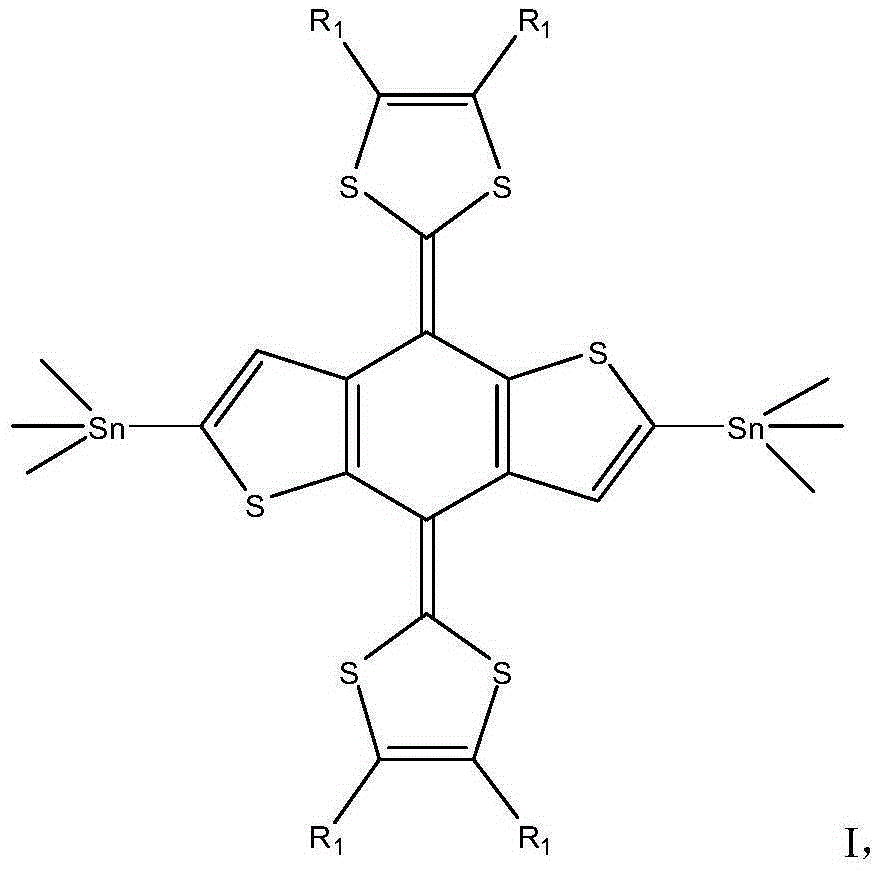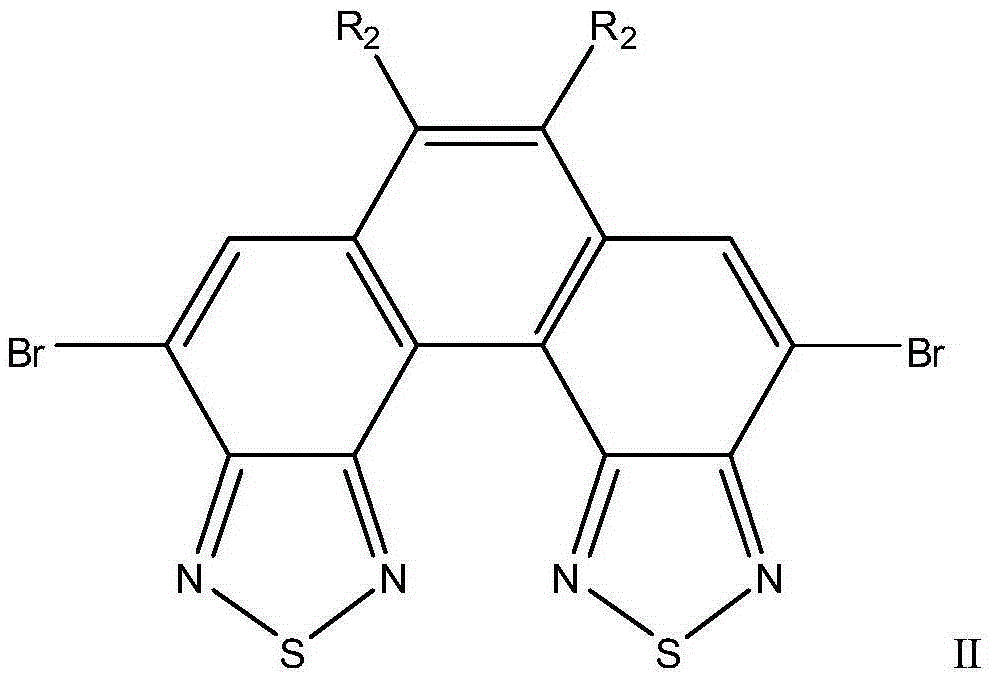Conjugated polymer for photovoltaic device, and preparation method and application of conjugated polymer
A conjugated polymer, optoelectronic device technology, applied in the fields of electric solid device, semiconductor/solid state device manufacturing, photovoltaic power generation, etc., can solve the problem that the absorption spectrum cannot be well matched with the solar spectrum, the energy transfer efficiency is low, and the energy conversion efficiency Low problems, to achieve the effect of improving photoelectric conversion efficiency, improving charge transport properties and stability, and simple structure
- Summary
- Abstract
- Description
- Claims
- Application Information
AI Technical Summary
Problems solved by technology
Method used
Image
Examples
Embodiment 1
[0047] This embodiment discloses a conjugated polymer P1 with the following structural formula:
[0048]
[0049] Among them, n=25, R 1 for C 16 h 33 , R 2 for C 10 h 21 .
[0050] The preparation process of conjugated polymer P1 is as follows:
[0051] One, have the preparation of the compound A of following structural formula:
[0052]
[0053] The preparation method of compound A comprises the steps:
[0054] 1. Under nitrogen protection, dissolve 1.32g (2.0mmol) of 2-dimethoxyphosphono-4,5-bis(hexadecyl)-1,3-dithiol (C) in 60mL of anhydrous tetrahydrofuran The solution was cooled to -78°C, and 2.0mL of 1.5M LDA (3.0mmol) cyclohexane solution was slowly added. After the addition was completed, the reaction was stirred at -78°C for 3h, and then 0.22g (1.0mmol) of benzo [1,2-b:4,5-b']dithiophene-4,8-dione (D) in 10mL anhydrous tetrahydrofuran solution for Wittig-Horner reaction, heat preservation reaction for 0.5h, return to room temperature, continue reaction fo...
Embodiment 2
[0079] This embodiment discloses a conjugated polymer P2 with the following structural formula:
[0080]
[0081] Among them, n=15, R 1 for H, R 2 for C 10 h 21 .
[0082] The preparation process of conjugated polymer P2 is as follows:
[0083] One, have the preparation of the compound A of following structural formula:
[0084]
[0085] The preparation method of compound A comprises the steps:
[0086] 1. Under the protection of nitrogen, cool the solution of 0.42g (2.0mmol) 2-dimethoxyphosphono-1,3-dithiol (C) in 40mL anhydrous tetrahydrofuran to -78℃, and slowly add 2.0mL concentration It is a solution of 1.5MLDA (3.0mmol) in cyclohexane. After the addition is complete, stir and react at -78°C for 3h, then add 0.22g (1.0mmol) of benzo[1,2-b:4,5-b'] 10 mL of anhydrous tetrahydrofuran solution of dithiophene-4,8-dione (D) was subjected to Wittig-Horner reaction, kept for 0.5 h, then returned to room temperature, continued for 12 h, and stopped the reaction. The ...
Embodiment 3
[0095] An organic solar cell device, using glass as a substrate, indium tin oxide (ITO) as a conductive layer, and using the conjugated polymer P1 in Example 1 as a conjugated polymer.
[0096] The structure of the organic solar battery device is: glass / ITO / PEDOT:PSS / active layer / Al, wherein ITO is indium tin oxide with a sheet resistance of 10Ω / □˜20Ω / □. PEDOT is poly(3,4-ethylenedioxythiophene), and PSS is poly(styrenesulfonic acid). The material of the active layer is a mixture, including the electron donor material based on the conjugated polymer P1 and the [6,6]phenyl-C 61 -Butyric acid methyl ester ([6,6]-phenyl-C61-butyric acid methylester, PCBM) is an electron acceptor material made of material.
[0097] The fabrication process of the organic solar cell device is as follows:
[0098] After the ITO glass is ultrasonically cleaned, it is treated with oxygen-Plasma, and a PEDOT:PSS layer is coated on the ITO, where the colon ":" indicates mixing.
[0099] On the PEDOT:P...
PUM
 Login to View More
Login to View More Abstract
Description
Claims
Application Information
 Login to View More
Login to View More - R&D
- Intellectual Property
- Life Sciences
- Materials
- Tech Scout
- Unparalleled Data Quality
- Higher Quality Content
- 60% Fewer Hallucinations
Browse by: Latest US Patents, China's latest patents, Technical Efficacy Thesaurus, Application Domain, Technology Topic, Popular Technical Reports.
© 2025 PatSnap. All rights reserved.Legal|Privacy policy|Modern Slavery Act Transparency Statement|Sitemap|About US| Contact US: help@patsnap.com



